| Contents
Home
General
Info
Ordering
Info
Contact us
Cartridge
Lists
Patent & Miscellaneous
Rim Fire
Center Fire Pistol
Center Fire Rifle
Metric Rimfire,
Pistol&Rifle
British Pistol and Rifle
Shotgun Shells
Cartridge Boxes &
Related
Posters
This Month's Picture Page
Index to
Picture Pages
Prior Picture Pages:
*
September 2003
*
October 2003
*
November 2003
*
December 2003
*
January 2004
*
February 2004
*
March 2004
*
April 2004
*
May 2004
*
June 2004
*
July 2004
*
August 2004
*
September 2004
*
October 2004
*
November 2004
*
December
2004
*
January 2005
*
February
2005
*
March
2005
*
April
2005
*
May 2005
* June 2005
* July 2005
*
August 2005
*
September
2005
*
October 2005
*
November 2005
*
December 2005
*
January 2006
*
February 2006
*
March 2006
*
April 2006
*May 2006
*June 2006
*July 2006
*August
2006
*September
2006
*October
2006
*November
2006
*December
2006
*January
2007
*February
2007
*March
2007
*April
2007
*May
2007
*June
2007
*July
2007
*August
2007
*September
2007
*October
2007
*November
2007
*December
2007
*January
2008
*February
2008
*March
2008
*April
2008
*May
2008
*June
2008
*July
2008
Links to Other Sites
Cartridge Collectors Organizations:
IAA
ECRA
SAAACA
Auctions:
Auction
Arms
E-Bay
Ward's Collectibles
Sold USA
Books:
Armory
Publications
WCF Publications
Other Collector's Sites:
Curtis Steinhauer
|
Home of the Old Ammo Guy's Virtual
Cartridge Trading Table
Featuring a wide range of antique,
obsolete, and modern ammunition for collectors
Picture
Page
August 2008
An very uncommon .41 revolver cartridge......
The United States Cartridge Company produced a relatively unknown cartridge
they called the .41 Colt Extra Short Centre Fire, which was listed as
adapted to 'Colt's Revolvers'. It is included in their 1891 and 1908
catalogs, so it was available at the very least between these two dates,
although I suspect it was developed earlier than 1891. The U.S.C. Co. 1881
catalog and an
 1882 advertising broadside do not include the
it.
The picture here was taken from the 1891
catalog, and shows both the .41 Short and the Extra Short. The double action
cartridges are designated as such and listed separately in the catalogs,
which would lead one to assume that the extra short cartridge was originally
intended for use in Colt's single action revolvers. In support of this
assumption, Jacob Brandt (Manual of Pistol and Revolver Cartridges) and
White and Munhall (Pistol and Revolver Cartridges) include the .41 Extra
Short Colt as another name for the .41 Short Colt Single Action. The U.S.C. Co. catalogs indicate
that the cartridge was loaded with a 130 grain bullet and 20 grains of
(black) powder, compared with the 165 grain bullet and 22 grain powder
charge of the .41 short. I have found no evidence that any other company
offered the .41 Extra Short cartridge. Winchester did produce a cartridge that is loaded with a short blunt-nosed 130 grain bullet and
20 grains of black powder, but it has a longer case and is listed as the .41
Long center fire in their 1879 catalog and simply the .41 center fire in later
catalogs. 1882 advertising broadside do not include the
it.
The picture here was taken from the 1891
catalog, and shows both the .41 Short and the Extra Short. The double action
cartridges are designated as such and listed separately in the catalogs,
which would lead one to assume that the extra short cartridge was originally
intended for use in Colt's single action revolvers. In support of this
assumption, Jacob Brandt (Manual of Pistol and Revolver Cartridges) and
White and Munhall (Pistol and Revolver Cartridges) include the .41 Extra
Short Colt as another name for the .41 Short Colt Single Action. The U.S.C. Co. catalogs indicate
that the cartridge was loaded with a 130 grain bullet and 20 grains of
(black) powder, compared with the 165 grain bullet and 22 grain powder
charge of the .41 short. I have found no evidence that any other company
offered the .41 Extra Short cartridge. Winchester did produce a cartridge that is loaded with a short blunt-nosed 130 grain bullet and
20 grains of black powder, but it has a longer case and is listed as the .41
Long center fire in their 1879 catalog and simply the .41 center fire in later
catalogs.
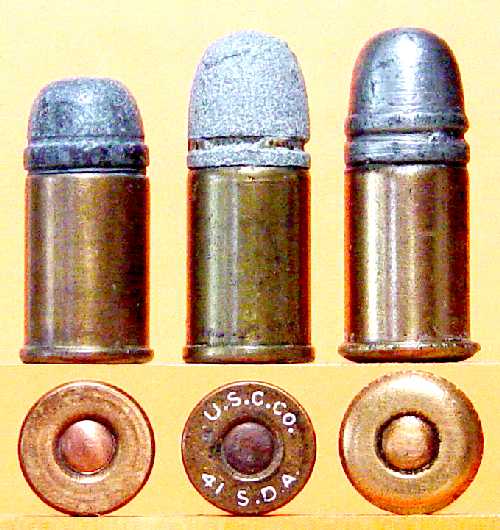 A group of cartridges were included in a recent on-line
auction, all matching with folded head unheadstamped cases, copper primers,
and short blunt-nose, belted bullets, which were described as .41 Extra Short
cartridges made by the United States Cartridge Company. The cartridge on the
left in this picture is one of those cartridges from the auction. The cases have high copper content typical of early U.S.C.
Co. cases, and the rounded primers are copper. I pulled one of the outside
lubricated bullets and it weighed 126 grains.
Dimensions are as follows: A group of cartridges were included in a recent on-line
auction, all matching with folded head unheadstamped cases, copper primers,
and short blunt-nose, belted bullets, which were described as .41 Extra Short
cartridges made by the United States Cartridge Company. The cartridge on the
left in this picture is one of those cartridges from the auction. The cases have high copper content typical of early U.S.C.
Co. cases, and the rounded primers are copper. I pulled one of the outside
lubricated bullets and it weighed 126 grains.
Dimensions are as follows:
bullet - .408"
case mouth - .408"
base - .408"
rim - .440"
case length - .608"
overall length - .925"
The second cartridge in the picture is a typical U.S.C. Co.
.41 Short Double Action with an outside lubricated bullet and a rounded
copper primer. It was developed for use in Colt's Model 1877 Lightning
double action revolver.
Its dimensions are:
bullet - .405"
case mouth - .408"
base - .408"
rim - .433"
case length - .622"
overall length - 1.082"
The third cartridge in the picture is an early U.S.C. Co. .41 Short Single
Action, developed for use in Colts Model 1874 New Line single action
revolver. This one also has an outside lubricated bullet, a high copper
content unheadstamped case and a rounded copper primer, but its rounded head
indicates that it was made sometime earlier that the .41 Extra Short. The
dimensions of this cartridge are:
bullet - .408"
case mouth - .406"
base - .408"
rim - .464"
case length - .632"
overall length - 1.088"
The cases of all three cartridges are similar. The difference in the case
lengths doesn't mean a whole lot, as I believe chambers of the Colt .41
revolvers were bored straight through, allowing the use of short and long as
well as inside and outside lubricated versions of the various .41 cartridges
with their confusing assortment of case lengths interchangeably. Contrary to
my initial reasoning and the information in Brandt and White & Munhall,
however, the rim of the extra short case more closely matches the double
action cartridge rather than the single action. This is a critical
dimension, because the Colt double action revolvers had chambers that were
closer together than those of the single action revolvers. Consequently, the
rims of adjacent cartridges would interfere with each other and not allow
the second cartridge to be fully chambered if one attempted to use single action cartridges in a double action
revolver.
 Shown
here is a picture of a box for these cartridges, which Brian Clark was kind
enough to send to me. It probably dates from sometime in the 1880s. The box
label states that the cartridges were intended to be used in Colt's
Double Action Pistol, and the
revolver pictured on the label backs this up, it being the very
desirable ejector-less Model 1877 Thunderer. I believe the RIFLE CARTRIDGES
over-label on the box was intended to circumvent
a tax that some Southern states levied on handgun cartridges, and has
nothing to do with the type of firearms they were actually intended to be
used in. I have yet to see a rifle chambered for any .41 Colt revolver
cartridge, but that certainly doesn't rule out the existence of such a
rifle. Shown
here is a picture of a box for these cartridges, which Brian Clark was kind
enough to send to me. It probably dates from sometime in the 1880s. The box
label states that the cartridges were intended to be used in Colt's
Double Action Pistol, and the
revolver pictured on the label backs this up, it being the very
desirable ejector-less Model 1877 Thunderer. I believe the RIFLE CARTRIDGES
over-label on the box was intended to circumvent
a tax that some Southern states levied on handgun cartridges, and has
nothing to do with the type of firearms they were actually intended to be
used in. I have yet to see a rifle chambered for any .41 Colt revolver
cartridge, but that certainly doesn't rule out the existence of such a
rifle.
 This
second picture was taken from the December, 1980 issue of the Gun Report
magazine, and was brought to my attention by Otto Witt. The box label
appears to be an exact duplicate of the label on the other box. including the
RIFLE CARTRIDGES over-label. As far as I know, a headstamped example of this
cartridge has not come to light, suggesting that production was so limited
as to not warrant the expense of a headstamp bunter. Consequently, it is
probable that only a single printing run of the labels was made; if that
assumption is correct, then all of the labels for this particular cartridge
will be the same. This second picture also shows the cartridge, which
matches the cartridge pictured above, as well as an insert that was in the
box indicating that the cartridge was intended as a target load. The
reduced powder charge and lighter bullet would be expected on
a short range, target load. This
second picture was taken from the December, 1980 issue of the Gun Report
magazine, and was brought to my attention by Otto Witt. The box label
appears to be an exact duplicate of the label on the other box. including the
RIFLE CARTRIDGES over-label. As far as I know, a headstamped example of this
cartridge has not come to light, suggesting that production was so limited
as to not warrant the expense of a headstamp bunter. Consequently, it is
probable that only a single printing run of the labels was made; if that
assumption is correct, then all of the labels for this particular cartridge
will be the same. This second picture also shows the cartridge, which
matches the cartridge pictured above, as well as an insert that was in the
box indicating that the cartridge was intended as a target load. The
reduced powder charge and lighter bullet would be expected on
a short range, target load.
.
A closer look at Smith & Wesson loading tools:
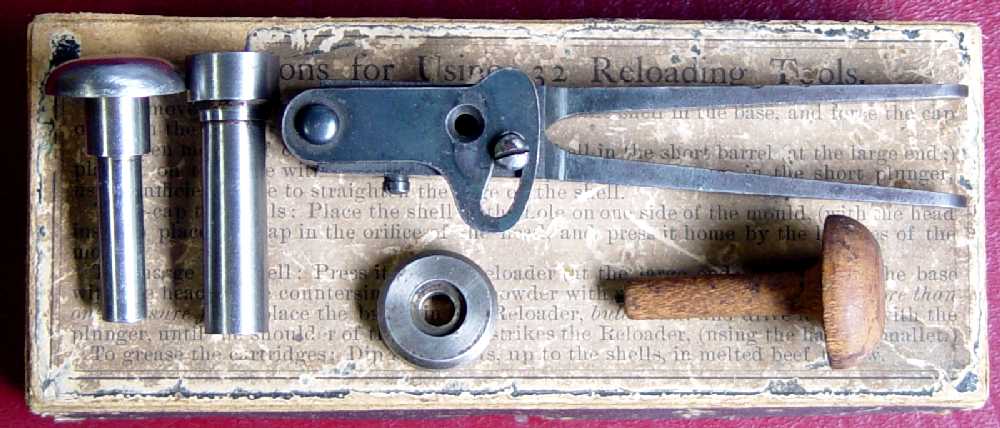
.
.
.
.
Several years ago, I included on one of my picture pages photos of the set
of .32 S&W reloading tools shown above. It was made by or for Smith &
Wesson between 1880 and 1889. These reloading tool sets were
made in .32, .38, and .44 caliber; prices for the three calibers on a March
1, 1883 advertising brochure were $1.50, $1.75, and $3.00
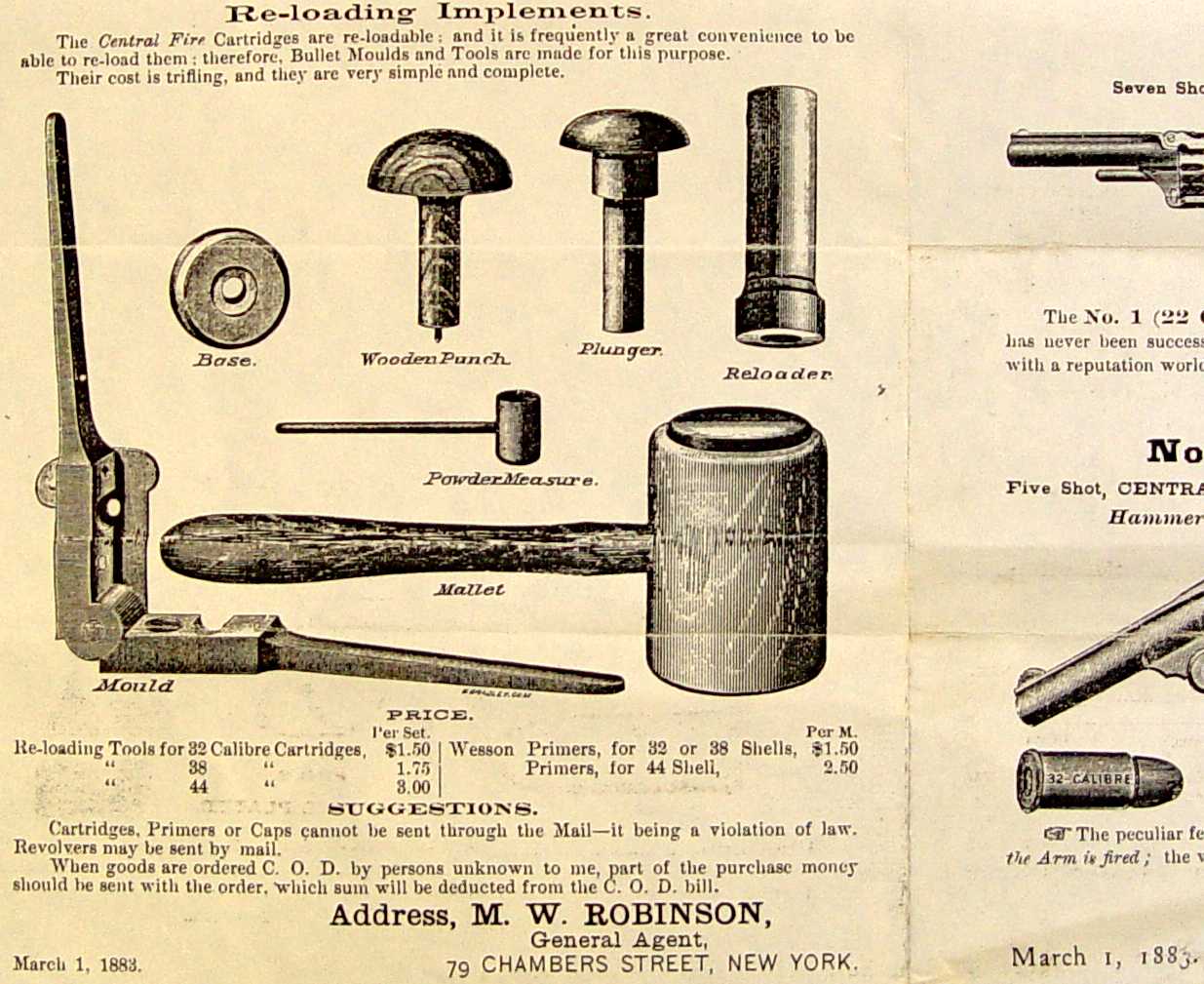 respectively.
I have included a portion of the 1883 brochure here that illustrates the
loading set. It appears I am missing two of the pieces, the mallet and the
powder measure. An 1888 Smith & Wesson broadside also has the loading set
illustrated, and indicates that the prices were unchanged for the .32 and
.38 sets; the price or the .44 set had dropped to $2.75, and $2.50 was now being
charged for a set of tools for the .320 revolving rifle cartridge. respectively.
I have included a portion of the 1883 brochure here that illustrates the
loading set. It appears I am missing two of the pieces, the mallet and the
powder measure. An 1888 Smith & Wesson broadside also has the loading set
illustrated, and indicates that the prices were unchanged for the .32 and
.38 sets; the price or the .44 set had dropped to $2.75, and $2.50 was now being
charged for a set of tools for the .320 revolving rifle cartridge.
The instructions for using the loading set are printed on a label on the top
of the box.
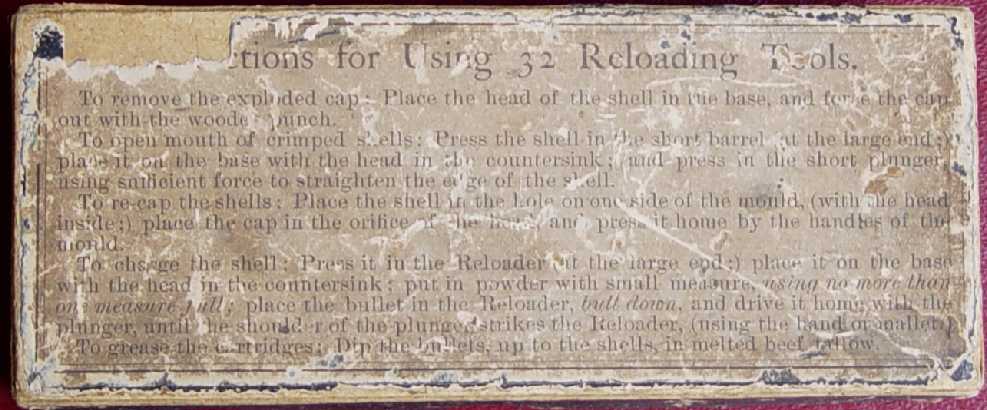
.
.
.
.
There are no other labels or markings on the box to indicate what cartridge
the tools are intended for, or that they were made or sold by Smith & Wesson, nor
is there any
evidence that there ever were any other labels. The
tools give no clue as to their caliber or their maker, as none of them is
marked in any way.
I recently picked up another partial set of .32 S&W loading tools, also
missing the mallet and powder measure, as well as the box and the wood
primer punch. Two bullet molds were included with these tools. Aside
from showing the effects of much more use and abuse,
 neither
matched my original mold in other ways. My original mold is at the top of each of
these pictures that show all sides of the three molds. The most obvious
difference in the molds is in the placement of the hole where the empty case
is inserted for repriming. On the first two molds this hole is in the right
half (when viewed from the handle end with the sprue side up). On the
opposite side from this hole is a screw that seats the new primer. This
screw can be adjusted to ensure that the primer is seated to the proper
depth in the head
of the cartridge case. There are also a couple of small differences in the
first two molds, these being the more rounded shape of the handle ends of
the neither
matched my original mold in other ways. My original mold is at the top of each of
these pictures that show all sides of the three molds. The most obvious
difference in the molds is in the placement of the hole where the empty case
is inserted for repriming. On the first two molds this hole is in the right
half (when viewed from the handle end with the sprue side up). On the
opposite side from this hole is a screw that seats the new primer. This
screw can be adjusted to ensure that the primer is seated to the proper
depth in the head
of the cartridge case. There are also a couple of small differences in the
first two molds, these being the more rounded shape of the handle ends of
the  second
mold, and a '32' stamped just ahead of the primer seating screw head, also
on the second mold. second
mold, and a '32' stamped just ahead of the primer seating screw head, also
on the second mold.
Remington Arms Company sold a line of reloading tool sets that was nearly
identical to the Smith & Wesson tools. They are so much alike that it is
possible both companies obtained them from the same source, receiving them
in generic boxes and adding their own labels prior to selling them. The
different arrangements of the case priming hole and screws can't be used to
distinguish between Smith & Wesson and Remington molds, as this tooling
apparently was not standardized for Smith & Wesson, and possibly not
for Remington as well. The general consensus among the reloading tool
collectors is that the rounded handle ends would indicate a Remington tool.
In addition, it is generally understood that Smith & Wesson tolls were not
marked. The presence of the .32 on the second mold, coupled with its rounded
handle ends, might indicate that it is a Remington product.
.
.
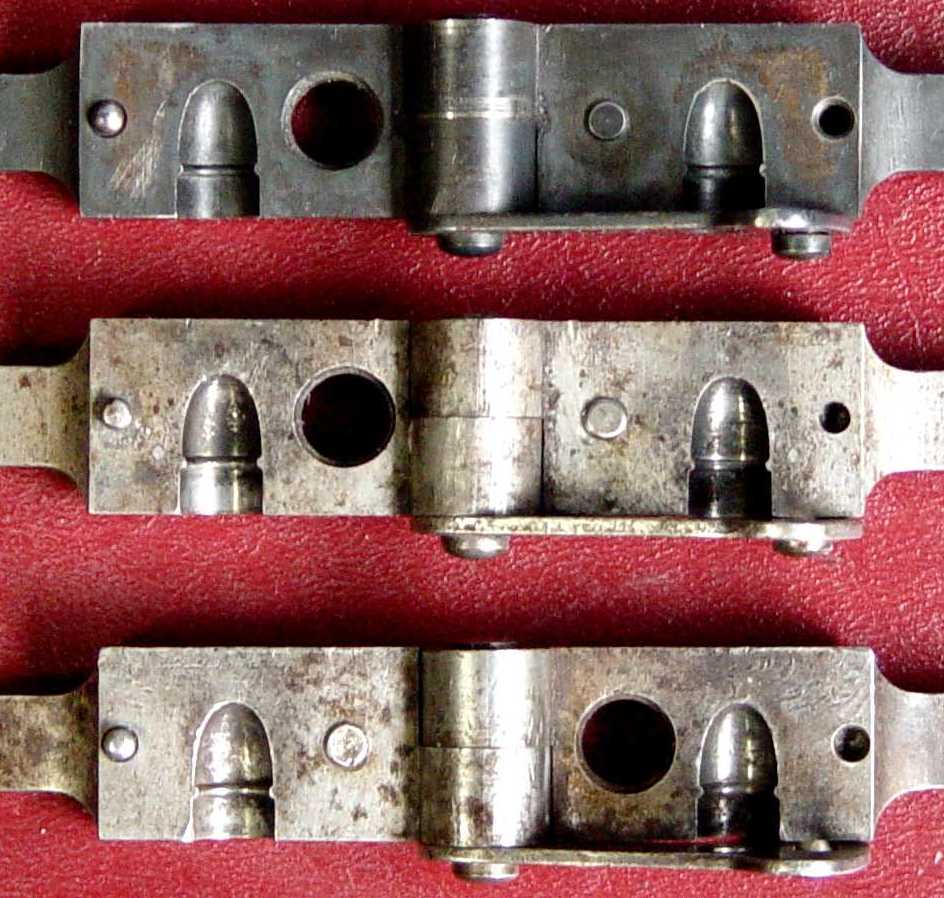 This
picture of the interiors of the molds provides a better perspective of the
placement of the priming hole and screw on each. More interesting, however,
are the matching bullet cavities of all three. I cast bullets using all
three of the molds and found that they produce matching bullets weighing about 94 grains. These
bullets are considered to be of the 'Merwin & Hulbert style', having a
deep grease groove which is positioned just above the case mouth when the
bullet is seated in the case. According to the loading instructions, the
bullet would be dipped in melted beef tallow after it was seated, filling
the groove and providing lubrication to the bore of the barrel when the
cartridge is fired. While the second mold has non-Smith & Wesson
characteristics, the fact that it produces the same
bullet as the other two would suggest that it is not a Remington mold. I'm not aware that
Remington produced any firearms chambered for the .32 S&W cartridge in significant enough numbers as to warrant
their stocking reloading tools in this caliber. This
picture of the interiors of the molds provides a better perspective of the
placement of the priming hole and screw on each. More interesting, however,
are the matching bullet cavities of all three. I cast bullets using all
three of the molds and found that they produce matching bullets weighing about 94 grains. These
bullets are considered to be of the 'Merwin & Hulbert style', having a
deep grease groove which is positioned just above the case mouth when the
bullet is seated in the case. According to the loading instructions, the
bullet would be dipped in melted beef tallow after it was seated, filling
the groove and providing lubrication to the bore of the barrel when the
cartridge is fired. While the second mold has non-Smith & Wesson
characteristics, the fact that it produces the same
bullet as the other two would suggest that it is not a Remington mold. I'm not aware that
Remington produced any firearms chambered for the .32 S&W cartridge in significant enough numbers as to warrant
their stocking reloading tools in this caliber.
.
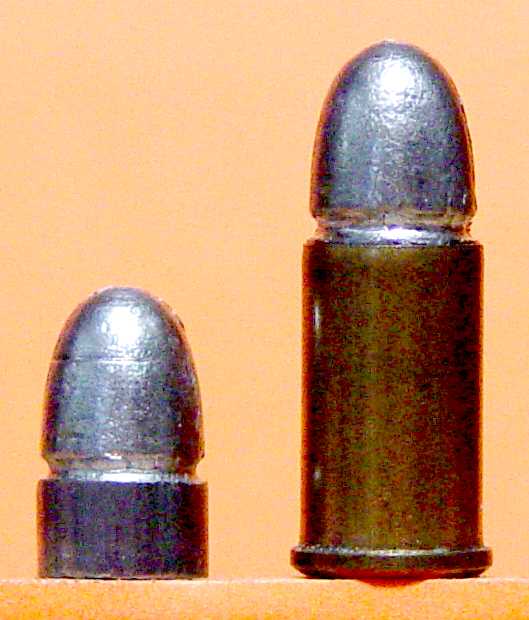
I used a set of these tools to seat one of the bullets; a newly cast bullet
and the loaded cartridge are shown here. Pushing the bullet through the
loading die sizes it prior to seating it in the case. Only that portion of
the bullet below the lubricating groove is sized, and measures .315" after
the process. Just above the groove, the bullet measures 308". Once the
bullet is seated in the case, this .308" measurement is all that is
available when determining dimensions of the cartridge unless the bullet is
removed from the case to expose the portion below the groove for measuring.
Note the similarity of the loaded cartridge shown here and the .32 S&W
cartridge illustrated in the lower right corner of the 1883 brochure above.
It should be pointed out that all of the earliest .32 and .38 Smith & Wesson
cartridges used grooved,
externally lubricated bullets. This is contrary to the information provided
in Chuck Suydam's U.S. Cartridges and Their Handguns, which states
that both cartridges when introduced were inside lubricated. Because the earliest of these cartridges were unheadstamped, they cannot be distinguished from the
'actual' .32 and .38 Merwin & Hulbert cartridges once they are removed from their boxes. At the
point that headstamps came into use in the mid-to-late 1880s, the transition to internally lubed, ungrooved
bullets on factory loaded .32 and .38 Smith & Wesson cartridges had already
been made. The Merwin & Hulbert cartridges never made this transition, and
continued to use the grooved externally lubed bullets until the end of their
production in the early 1900s.
.
.
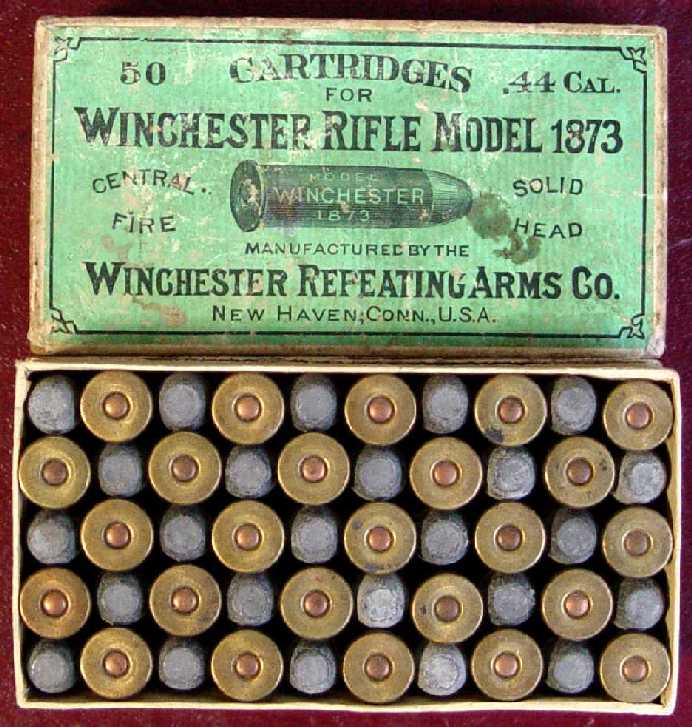
|

 Shown
here is a picture of a box for these cartridges, which Brian Clark was kind
enough to send to me. It probably dates from sometime in the 1880s. The box
label states that the cartridges were intended to be used in Colt's
Shown
here is a picture of a box for these cartridges, which Brian Clark was kind
enough to send to me. It probably dates from sometime in the 1880s. The box
label states that the cartridges were intended to be used in Colt's
 neither
matched my original mold in other ways. My original mold is at the top of each of
these pictures that show all sides of the three molds. The most obvious
difference in the molds is in the placement of the hole where the empty case
is inserted for repriming. On the first two molds this hole is in the right
half (when viewed from the handle end with the sprue side up). On the
opposite side from this hole is a screw that seats the new primer. This
screw can be adjusted to ensure that the primer is seated to the proper
depth in the head
of the cartridge case. There are also a couple of small differences in the
first two molds, these being the more rounded shape of the handle ends of
the
neither
matched my original mold in other ways. My original mold is at the top of each of
these pictures that show all sides of the three molds. The most obvious
difference in the molds is in the placement of the hole where the empty case
is inserted for repriming. On the first two molds this hole is in the right
half (when viewed from the handle end with the sprue side up). On the
opposite side from this hole is a screw that seats the new primer. This
screw can be adjusted to ensure that the primer is seated to the proper
depth in the head
of the cartridge case. There are also a couple of small differences in the
first two molds, these being the more rounded shape of the handle ends of
the